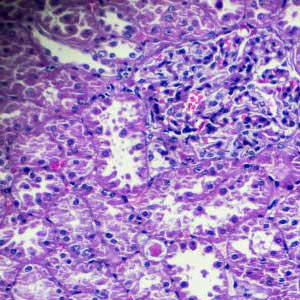Renal biopsy in Anantapur
Renal biopsy in Anantapur is a medical procedure performed to obtain kidney tissue for examination in a laboratory setting. The term "renal" pertains to the kidneys, which is why this procedure is often referred to as a kidney biopsy.
Functions of a healthy kidney
Healthy individuals possess two kidneys that carry out numerous essential functions. The responsibilities of the kidneys include
- Eliminating urea (liquid waste) from the bloodstream through urine production
- Maintaining the equilibrium of chemicals, such as sodium and potassium, within the blood
- Producing the hormone erythropoietin, which facilitates the development of red blood cells
- Regulating blood pressure by generating the hormone renin
- Assisting in the activation of the hormone calcitriol, which governs calcium absorption and levels in the blood

Should routine blood and urine analyses reveal that your kidneys are not functioning effectively, your physician may opt to conduct a renal biopsy.
Major process for renal biopsy at Renal biopsy hospitals in Anantapur
The examination assists your physician in determining the specific type of kidney disease present, its severity, and the most appropriate treatment options. Additionally, a renal biopsy may be utilized to assess the efficacy of kidney treatments and to detect any complications that may arise after a kidney transplant.
There are two primary methods for conducting a renal biopsy by Kidney Biopsy Specialists in Anantapur
- Percutaneous biopsy (renal needle biopsy) is the most frequently utilized approach. In this procedure, a physician employs a slender biopsy needle, which is inserted through the skin to extract tissue from the kidney. Imaging techniques such as ultrasound or CT scans may be utilized to accurately guide the needle to the targeted region of the kidney.
- Open biopsy (surgical biopsy) involves the surgeon making an incision in the skin adjacent to the kidneys. This technique enables the physician to visually assess the kidneys and identify the specific area from which tissue samples should be collected.
The timing of your release will depend on various factors, including your overall health status, the protocols of your physician, and your response to the procedure. Typically, you will be moved to a recovery area for rest and observation. Nephrologist for Renal Biopsy in Anantapur will monitor your vital signs, such as blood pressure, temperature, pulse, and respiratory rate. Additionally, a complete blood count and urine analysis will be conducted to check for any internal bleeding or complications. Pain relief medication will also be administered at the biopsy site. It is important to refrain from activities such as jogging, aerobics, or any other movements that may cause bouncing for a duration of two weeks following your biopsy by Renal biopsy doctor in Anantapur, Dr. M. Surendra Babu.
